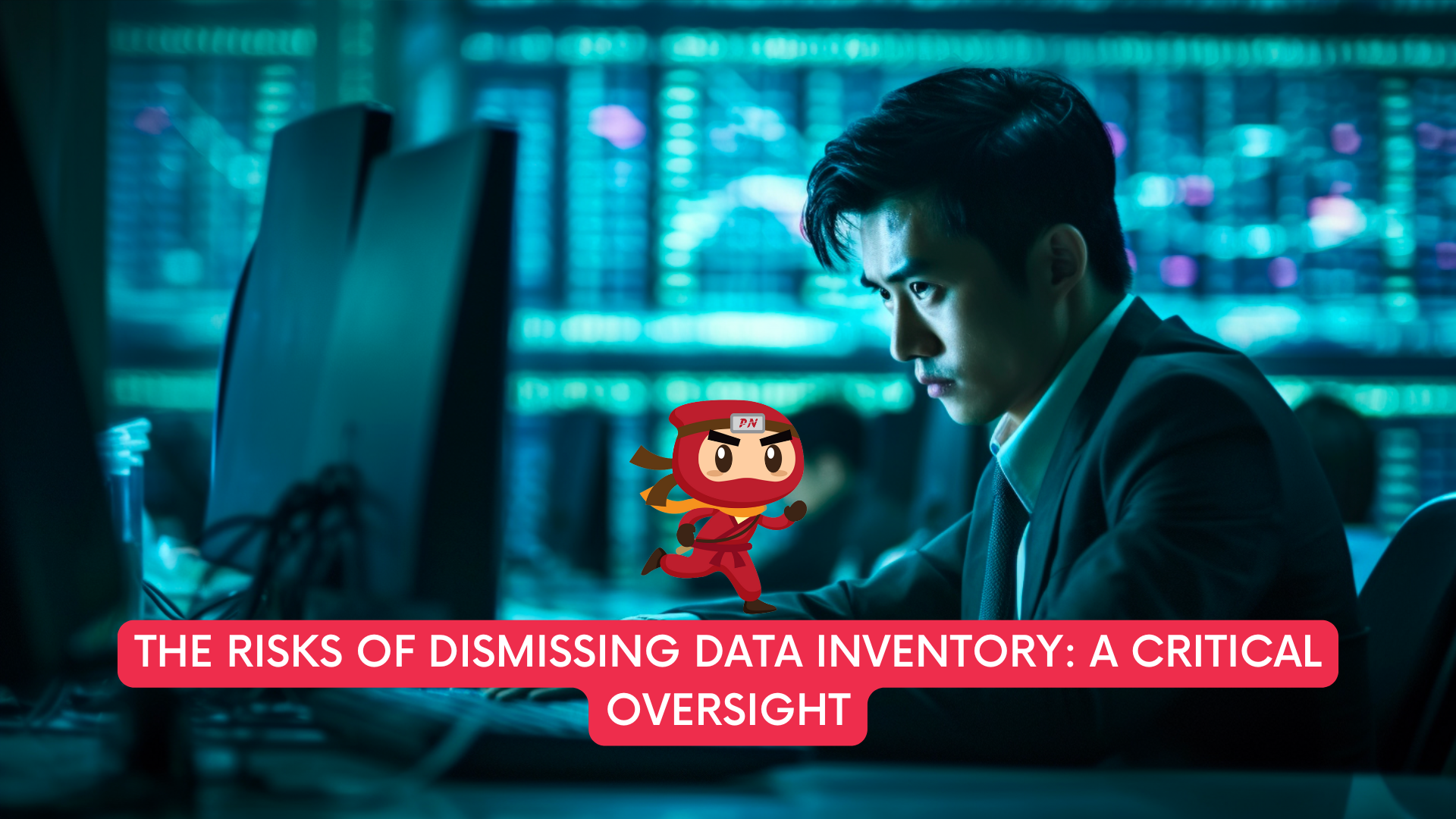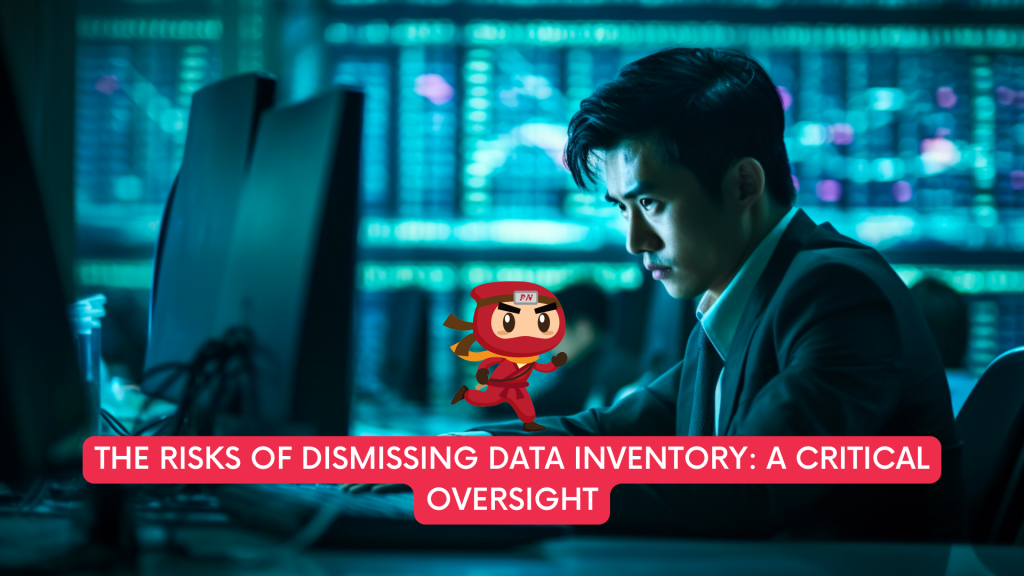KEEP IN TOUCH
Subscribe to our mailing list to get free tips on Data Protection and Cybersecurity updates weekly!







In the era of big data, businesses across the globe are collecting and processing unprecedented volumes of information. From customer details and financial records to proprietary business strategies, data has become one of the most valuable assets a company can possess. However, as the volume and variety of data increase, so does the complexity of managing it. One critical component of data management that is often overlooked is data inventory. Failing to maintain a comprehensive data inventory can have serious consequences, ranging from data breaches and regulatory penalties to inefficiencies and missed business opportunities for compliance reasons. This article explores the risks associated with dismissing data inventory and underscores the importance of maintaining a thorough and up-to-date record of all data assets, which is crucial for delivering business value and driving organizational success. Implementing robust security protocols is essential to ensure the reliability and security of these data assets, and effective data governance plays a key role in this process.
Adhering to data privacy regulations, such as GDPR and CCPA, is essential when managing consumer data to avoid legal repercussions and ensure trust.
A data inventory is essentially a detailed catalog of all the data assets an organization holds. It includes information about what data is collected, where it is stored, how it is processed, who has access to it, and how it is protected. Data inventories are crucial for several reasons: they help organizations understand their data landscape, ensure compliance with data protection regulations, improve data security, optimize data management processes, and maintain high data quality.
In an increasingly digital world, businesses rely on data to drive decision-making, enhance customer experiences, and gain competitive advantages. However, without a clear data management strategy and understanding of what data they possess and how it is used, organizations can quickly lose control over their data assets. This lack of control not only hampers operational efficiency but also exposes the organization to significant risks. A well-defined governance strategy is essential to align data governance efforts with organizational goals and ensure effective execution by all stakeholders.

One of the most immediate and severe risks of neglecting data inventory is the increased likelihood of data breaches and security incidents. When an organization does not have a clear understanding of where its data resides, it becomes difficult to protect that data effectively through proper data protection measures. Implementing stringent security protocols is essential to ensure the reliability of critical computing infrastructure and protect data effectively. Unmonitored and undocumented data can easily become a target for cybercriminals, who exploit vulnerabilities in the system to gain unauthorized access.
For example, sensitive information stored in an outdated or forgotten database may not be subject to the same security measures as more visible data assets. This creates an entry point for attackers who can infiltrate the system undetected. Data breaches not only result in the loss of sensitive information but also damage an organization’s reputation and lead to significant financial losses through fines, legal fees, and lost business. Protecting customer data is crucial to avoid these consequences and ensure compliance with industry regulations.
2. Regulatory Non-Compliance
In today’s regulatory environment, data compliance is becoming increasingly stringent. Regulations such as the General Data Protection Regulation (GDPR) in Europe and the California Consumer Privacy Act (CCPA) in the United States impose strict requirements on how organizations collect, store, and manage personal data. A critical aspect of these regulations is the ability to demonstrate that the organization has control over its data and can protect it adequately.
Without a comprehensive data inventory, it is nearly impossible for an organization to ensure compliance with these regulations. For instance, under GDPR, organizations are required to provide individuals with information about how their data is processed and to manage internal processes to delete data upon request. If an organization does not have a clear inventory of its data, it may fail to locate and delete the necessary information, resulting in regulatory violations. Non-compliance can lead to hefty fines, legal actions, and a loss of consumer trust.
3. Inefficient Data Management
Data is a powerful resource, but only if it is managed effectively. When organizations lack a clear inventory of their data, they often struggle with inefficiencies in data management. For example, duplicate data may be stored across multiple systems, leading to unnecessary storage costs and complicating data retrieval. Additionally, without a clear understanding of data flows and dependencies, organizations may face challenges in integrating new systems or scaling operations.
Inefficient data management can also hinder an organization’s ability to leverage data for strategic decision-making. If decision-makers do not have access to accurate and up-to-date information, they may make decisions based on incomplete or outdated data, leading to suboptimal outcomes. In today’s fast-paced business environment, where data-driven insights are critical for success, these inefficiencies can put an organization at a significant disadvantage.

4. Missed Business Opportunities
In addition to operational inefficiencies, dismissing data inventory can result in missed business opportunities. Data is a valuable asset that can drive innovation, improve customer experiences, and uncover new revenue streams. However, to harness the full potential of data, organizations must first understand what data they have and how it can be used.
Without a comprehensive data inventory, organizations may overlook valuable data assets or fail to recognize the potential applications of their data. For example, a company might have customer behavior data that could be used to personalize marketing efforts or develop new products, but without a clear inventory, this data may remain untapped. By neglecting data inventory, organizations risk missing out on opportunities to enhance their competitive edge and drive growth.
5. Challenges in Incident Response
In the event of a cybersecurity incident, the speed and effectiveness of an organization’s response are crucial in minimizing damage. However, without a clear inventory of data, incident response teams may struggle to assess the impact of the breach and take appropriate action. For instance, if an organization does not know where sensitive data is stored, it may not be able to determine whether that data has been compromised or how to contain the breach.
Moreover, without a comprehensive data inventory, organizations may find it difficult to notify affected individuals and regulatory authorities within the required timeframes, as mandated by data protection regulations. Delays in responding to a breach can exacerbate the damage, both in terms of financial losses and reputational harm. Establishing guidelines to prevent security breaches, including authentication, permission, encryption, and monitoring, is essential to mitigate these risks.

Given the significant risks associated with dismissing data inventory, it is essential for organizations to prioritize the development and maintenance of a comprehensive data inventory as part of their data lifecycle management. This process involves several key steps that involve key stakeholders:
The first step in creating a data inventory is to conduct a thorough data discovery process. This involves identifying all data sources within the organization, including structured data (such as databases) and unstructured data (such as emails, documents, and social media content). Data discovery tools can automate this process, helping organizations locate and catalog data across their networks.
2. Data Classification
Once data has been discovered, it should be classified based on its sensitivity and importance. Data classification helps organizations prioritize their security efforts, ensuring that the most critical data is protected with the highest level of security. For example, personal data and intellectual property may require more stringent security measures than less sensitive data.
3. Data Mapping
Data mapping involves documenting how data flows through the organization, including where it is collected, how it is processed, and where it is stored. This step is crucial for understanding data dependencies and ensuring compliance with data protection regulations. Data mapping also helps organizations identify potential vulnerabilities in their data handling processes.
4. Regular Audits and Updates
A data inventory is not a one-time effort; it requires regular audits and updates to remain accurate and effective. As new data is collected and existing data is modified or deleted, the inventory should be updated to reflect these changes. Regular audits can help organizations identify gaps in their inventory and address any inconsistencies. Additionally, reviewing financial statements can ensure that all data-related financial activities are accurately reported and compliant with regulatory standards.
5. Employee Training and Awareness
Finally, it is important to ensure that all employees are aware of the importance of data inventory and their role in maintaining it. Training programs can educate employees about data handling best practices and the risks associated with poor data management. By fostering a culture of data awareness, organizations can improve the accuracy and reliability of their data inventory.

In an increasingly data-driven world, dismissing the importance of data inventory is a critical oversight that can expose organizations to a wide range of risks. From data breaches and regulatory non-compliance to inefficiencies, missed business opportunities, and the mishandling of consumer data, the consequences of neglecting data inventory can be severe. By prioritizing the development and maintenance of a comprehensive data inventory, organizations can safeguard their data assets, ensure regulatory compliance, and unlock the full potential of their data to drive business success. Staying current with regulatory requirements is essential to avoid inaccuracies and ensure that all data practices align with the latest standards and guidelines within a robust data governance framework.
Your appointed DPO can work with you on your PDPA compliance, ensuring that there will be policies in place to make sure that the handling of personal data is PDPA compliant.
A Data Protection Officer (DPO) oversees data protection responsibilities and ensures that organisations comply with the Personal Data Protection Act (PDPA). Furthermore, every Organisation’s DPO should be able to curb any instances of PDPA noncompliance as it is the officer responsible for maintaining the positive posture of an organisation’s cybersecurity.
DPOs complement organisations’ efforts to ensure that the organisation’s methods of collecting personal data comply with the PDPA. It also ensures that policies are set in place to make sure that there will be no instances of data breaches in the future.
Don’t wait any longer to ensure your organisation is PDPA compliant. Take our free 3-minute PDPA Compliance Self-audit checklist now, the same “secret weapon” used by our clients to keep them on track. Upon completion, we will send you the results so you can take the necessary action to protect your customers’ data. Complete the free assessment checklist today and take the first step towards protecting your customers’ personal data.